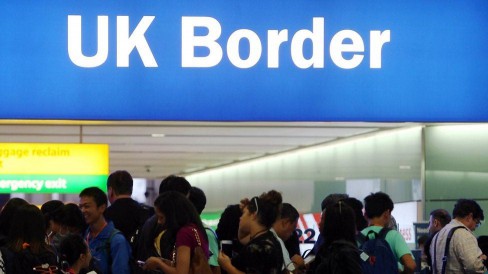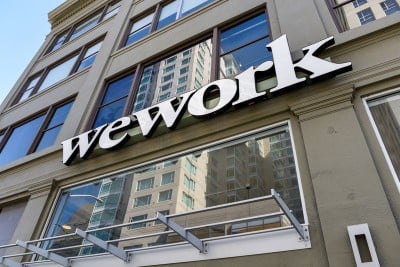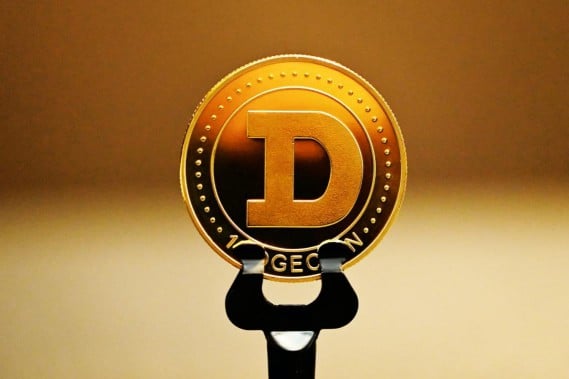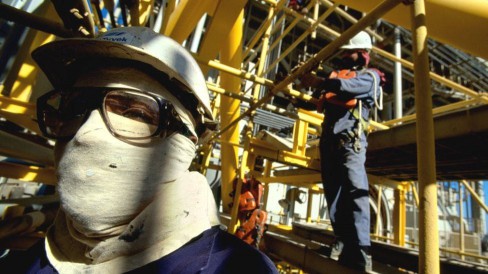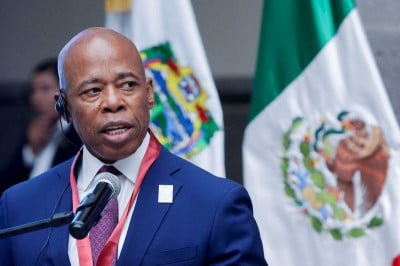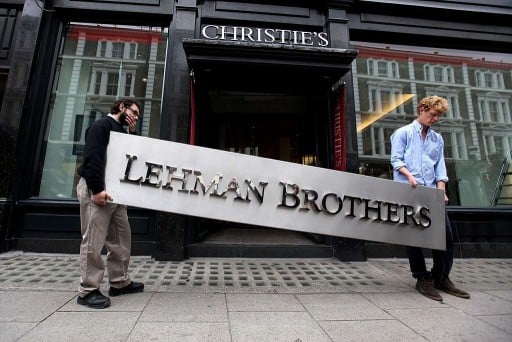
Oli Scarff / Getty Images
On Monday, September 15, 2008, at 1:45 a.m., Lehman Brothers Holdings Inc. filed a bankruptcy petition in the United States Bankruptcy Court for the Southern District of New York. It was the largest bankruptcy proceeding in U.S. history. The 164-year-old firm was the fourth-largest U.S. investment bank, and its bankruptcy kicked off a global financial crisis.
Lehman used a high-leverage business model that required it to raise billions of dollars every day to keep the doors open. In 2006, it had invested heavily in high-risk real estate and subprime mortgages. When these markets turned south, Lehman couldn’t raise enough cash to stay in business.
Key Takeaways
- The Lehman Brothers bankruptcy was the largest in U.S. history.
- It invested heavily in risky mortgages just as housing prices started falling.
- The government could not bail out Lehman without a buyer.
- Lehman’s bankruptcy kicked off the 2008 financial crisis.
- The financial crisis impacted millennials heavily.
How the Government Tried To Save Lehman Brothers
U.S. Treasury Secretary Hank Paulson and Federal Reserve Chairman Ben Bernanke grew concerned over a potential Lehman Brothers bankruptcy in March 2008. That was after the Fed rescued investment bank Bear Stearns. The expectation was that Lehman would be the next to need help.
Paulson urged Dick Fuld, Lehman’s president, to find a buyer as Bear Stearns had done, and Paulson personally encouraged the only two banks who were interested: Bank of America and British Barclays. He warned both that neither the Treasury nor the Fed could help with government funds.
Note
The U.S. Treasury had no legal authority to invest capital in Lehman Brothers, as Congress hadn’t yet authorized the Troubled Asset Relief Program.
Since Lehman Brothers was an investment bank, the government could not nationalize it like it did government enterprises Fannie Mae and Freddie Mac. For that same reason, no federal regulator, like the FDIC, could take it over.
Moreover, the Fed couldn’t guarantee a loan as it did with Bear Stearns. Lehman Brothers didn’t have enough assets to secure one.
Bank of America didn’t want a loan, anyway. It wanted the government to cover $65 billion to $70 billion in anticipated losses. Paulson said no. Instead, he and Federal Reserve of New York President Tim Geithner sponsored a weekend retreat with the nation's top bankers to find funding for Lehman Brothers.
The bankers spent the next two days trying to find a way to make it work. But before they could, Bank of America backed out of the deal. The next day, Barclays announced its British regulators would not approve a Lehman Brothers deal. Everyone spent the rest of the day preparing for Lehman's bankruptcy.
Causes of Lehman’s Bankruptcy
Lehman’s bankruptcy had four underlying causes:
- Risk: The bank had taken on too much risk without a corresponding ability to raise cash quickly. In 2008, it had $639 billion in assets, technically more than enough to cover its $613 billion in debt. However, the assets were difficult to sell. As a result, Lehman Brothers couldn’t sell them to raise sufficient funds. That cash flow problem is what led to its bankruptcy.
- Culture: Management rewarded excessive risk-taking. Lehman’s chief risk officer said that top management ignored many of her risk-management strategies. Top managers wanted to stay ahead of competitors that also used high-risk strategies, and they also thought the company was too smart to fail.
- Overconfidence: The firm relied on complicated financial products based on quick real estate growth just as the real estate market began to decline. Between 2000-2006, its revenue grew 130% thanks to early successes with mortgage-backed securities. In 2003-2004, Lehman Brothers bought five mortgage lenders, which allowed it to originate and underwrite subprime loans, increasing its profitability. In March 2006, Lehman bought heavily into commercial real estate and risky loans and instead of selling them right away, it kept them on its books. Management thought it would make more money owning these assets but its timing couldn’t have been worse, as real estate prices were falling.
- Regulator inaction: The Securities and Exchange Commission and other regulators didn’t take action. As early as 2007, the SEC knew Lehman Brothers was taking on too much risk, but the agency never required Lehman to do anything about it. It also didn’t publicly disclose to rating agencies that the bank had exceeded risk limits.
Impact of Lehman’s Bankruptcy
Lehman’s bankruptcy sent financial markets reeling. The Dow Jones Industrial Average fell 504.48 points, its worst decline in seven years. Losses continued until March 5, 2009, when the Dow closed at 6,594.44. That was a 53% drop from its peak of 14,164.53 on October 10, 2007. Investors fled to the relative safety of U.S. Treasury bonds, sending prices up.
Investors knew that Lehman’s bankruptcy threatened the financial institutions that owned its bonds. On September 16, 2008, the Reserve Primary money market fund "broke the buck." That meant its shares, normally worth at least $1, were only worth $0.97. Investors lost confidence in the money market fund when it announced losses of $785 million in Lehman’s commercial paper.
On September 17, 2008, the collapse spread. Investors withdrew a record $196 billion from their money market accounts. If the run had continued, businesses wouldn’t have been able to get money to fund their day-to-day operations. In just a few weeks, the economy would have collapsed. For example, shippers wouldn’t have had the cash to deliver food to grocery stores.
On September 18, 2008, Paulson and Bernanke met with congressional leaders to explain that credit markets were only a few days away from a meltdown. They asked for $700 billion to bail out the banks, which would allow the Treasury Department to buy shares of troubled banks; It was the fastest way to inject capital into the frozen financial system.
On September 29, 2008, Congress rejected the proposal. That sent the Dow down 777.68 points, the most in any single day in history until 2018.
How the Bankruptcy Affects You Today
The Lehman Brothers bankruptcy kicked off the 2008 financial crisis and the recession that followed. The millennial generation was just entering the workforce and therefore were the most heavily impacted.
Note
Millennials are those born between 1981 and 1996.
Unemployment rates skyrocketed, but millennials suffered the most—unemployment rates for those aged 16-24 rose from 9.9% in May 2007 to a record 19.5% by April 2010. Unemployment was at 8.8% for 25-54-year-olds and 7.0% for those 55 and older. By December 2017, unemployment had fallen to 8.9% for millennials, but the damage had already been done.
The recession’s impact on millennials is striking when compared to previous generations at the same age.
- They have less wealth.
- They have more student debt.
- They are more likely to live with their parents.
- They are slower in forming families.
The one positive impact is that millennials are more highly educated than in past generations. Since jobs weren’t available, Millennials went to school, which has paid off for those with a college degree. Their median household income is double that for those with only a high school degree.
Lehman’s bankruptcy also set the stage for the Dodd-Frank Wall Street Reform Act. It was the most comprehensive financial reform since the Glass-Steagall Act. Glass-Steagall regulated banks after the 1929 stock market crash, but it was repealed in 1999. That allowed banks to once again invest depositors' funds in unregulated derivatives like mortgage-backed securities.
Dodd-Frank established the Financial Stability Oversight Council, which identifies risks that affect the entire financial industry. If any firm becomes too big, the FSOC will turn them over to the Federal Reserve for closer supervision. For example, the Fed can make a bank increase its reserve requirement, making sure they have enough cash on hand to prevent bankruptcy.
Frequently Asked Questions (FAQs)
Who bought Leman Brothers?
Barclays ended up buying Lehman Brothers' U.S. operations the day after it filed for bankruptcy, and Normura purchased the firm's Asian and European operations a week later.
What happened to Lehman Brothers stock?
Lehman Brothers stock peaked at over $86 per share in February 2007. It began plummeting in September 2008 before becoming basically worthless when Lehman Brothers filed for bankruptcy.

